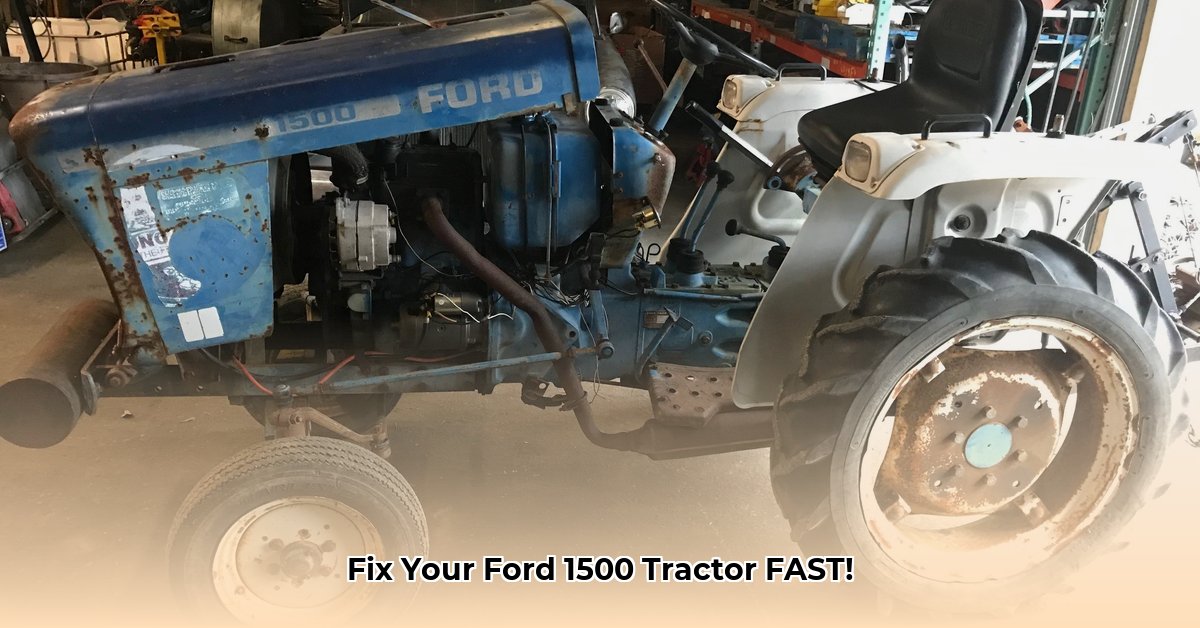
Dealing with a temperamental Ford 1500 tractor can be frustrating, but many common issues are easily resolved with some DIY know-how. This guide provides practical, step-by-step solutions for common problems, empowering you to get your tractor back in peak condition. For more troubleshooting tips on similar Ford tractors, check out this helpful resource: Ford 1300 Problems.
Engine Troubles: Addressing Compromised Engine Block Threads
A frequent issue with Ford 1500 engines involves stripped threads in the engine block. This problem, while daunting, is manageable with the right approach.
1. Assess the Damage: Carefully inspect the stripped threads. Note the extent of the damage—minor wear versus complete thread failure. Photography is crucial for later reference.
2. Enlarge and Retap: This precise procedure involves carefully enlarging the damaged hole using a drill bit of the appropriate size, followed by retapping (cutting new threads) with a tap of the correct size and thread pitch. Remember: This requires precision; utilize a vice and appropriate drill guide if available. Improper drilling can lead to irreversible damage.
3. Installation and Testing: Install new bolts or studs, ensuring a snug fit without over-tightening. Start the engine and carefully monitor for any leaks. Re-check your work if leaks appear.
- Safety Note: Always wear safety glasses, gloves, and appropriate clothing when working on engine components. Seek professional help if unsure about any step. Have a fire extinguisher readily available.
Hydraulic System Woes: Cleaning and Prevention
Contamination (dirt, debris, old fluid) severely impacts the hydraulic system's performance. Common sources include worn cylinder packing and the differential lock clutch.
1. Identify the Source: Inspect all hydraulic components for leaks, damage, or wear. Note your findings; photographs are helpful.
2. Deep Clean and Flush: Thoroughly clean and flush the hydraulic system according to your owner's manual. This is critical for long-term health. Improper flushing can cause further damage.
3. Filter Replacement: Replace all hydraulic filters with filters meeting your tractor's specifications. Regular filter changes are critical. Don't skimp on quality.
- Preventative Maintenance: Regular fluid and filter changes (every 50-100 hours) are essential to avoid costly repairs. Does regular maintenance seem tedious? Consider the alternative: a major hydraulic system failure.
Electrical Gremlins: Troubleshooting Key Switches and Glow Plugs
Electrical problems, particularly with the key switch and glow plugs, are common.
1. Key Switch Cleaning: Begin by cleaning the key switch contacts thoroughly. Often, this simple action resolves the issue. Use a contact cleaner to remove any corrosion.
2. Wiring Inspection: Inspect all wiring related to the key switch and glow plugs for damage, corrosion, or loose connections. Repair or replace damaged wires.
3. Component Replacement: If cleaning and inspection fail, consider replacing the key switch or glow plugs with OEM-approved parts.
- Did you know? A faulty glow plug can lead to hard starting, especially in cold weather. Regularly checking their integrity and replacing faulty ones is crucial.
The Neutral Safety Switch: Addressing a Critical Safety Feature
The neutral safety switch prevents accidental starting when the transmission isn't in neutral. Troubleshooting this can be challenging—often involving the actuator mechanism rather than the switch itself—and requires consulting your owner's manual or online forums for specific solutions. Never bypass this switch; your safety is paramount.
Preventative Maintenance: A Proactive Approach
Regular maintenance is key to a longer-lasting Ford 1500.
| Task | Recommended Frequency | Importance |
|---|---|---|
| Fluid Changes | Every 50-100 hours | Prevents sludge and ensures smooth operation. |
| Filter Replacements | Every 50-100 hours | Prevents contamination and protects components. |
| Component Inspections | Monthly/Yearly | Early detection of wear and tear prevents major problems. |
| Consult Owner's Manual | As Needed | Your primary resource for specific maintenance procedures for your model. |
Sourcing Parts: Finding the Right Components
Finding parts for older tractors can be challenging. Explore these options: online retailers specializing in agricultural equipment, salvage yards, and online tractor forums.
Ford 1500 Tractor Problems: A Quick Reference
| Problem | Potential Causes | Troubleshooting Steps |
|---|---|---|
| Stripped Engine Block Threads | Worn or damaged threads | Enlarge and retap; install new bolts/studs. |
| Hydraulic System Contamination | Worn seals, dirty fluid | Clean and flush system; replace filters; inspect components. |
| Key Switch/Glow Plug Issues | Damaged or corroded key switch; damaged wiring | Clean or replace switch; inspect and repair wiring. |
| Neutral Safety Switch Issue | Worn switch; faulty wiring | Consult online forums and your owner's manual. |
Remember, you're not alone. Engage with online communities to access shared knowledge and solutions. This guide provides a foundation, but combining this with community support can significantly enhance your tractor maintenance capabilities.